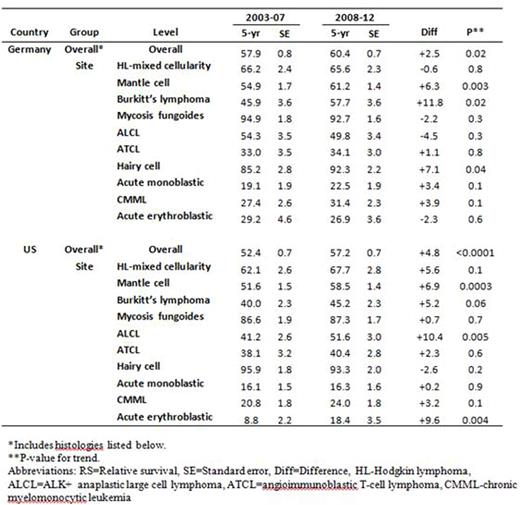Abstract
Introduction: Population level survival has increased for most of the more common hematologic malignancies in the early 21st century. However, less information is available on population level changes in survival for patients with rare hematologic malignancies. Here, we examine survival for rare hematologic malignancies in Germany and the United States (US).
Methods: Cases of rare hematologic malignancies were extracted from the Surveillance, Epidemiology, and End Results (SEER13) database in the US, with an underlying population of 44.1 million people, and 12 regional cancer databases in Germany, with an underlying population of 28.3 million. For the purpose of this study, rare hematologic malignancies were defined as those having an incidence of less than 1 per 10,000 population in both the relevant databases. Modeled period analysis was used to examine changes in 5-year survival between 2003-07 and 2008-12 and to derive p-values for the comparison between the two periods.
Results: Ten malignancies that met the inclusion criteria and had adequate case numbers to allow a meaningful analysis were identified (see table.) A total of 13,895 cases were identified in Germany and 19,894 in the US with case numbers for individual morphologies ranging from 302 for acute erythroblastic leukemia in Germany to 4,514 for mantle cell lymphoma in the US. Overall 5-year relative survival for patients with all morphologies was estimated as 60.4% in Germany and 57.2% in the US in 2008-12. Survival for patients varied widely depending on the individual tumor type, from less than 30% for acute monoblastic leukemia and acute erythroblastic leukemia to around 90% for hairy cell leukemia and mycosis fungoides without Sezary. A statistically significant increase in survival was observed for mantle cell lymphoma, Burkitt's lymphoma, and hairy cell leukemia in Germany and for mantle cell lymphoma, anaplastic lymphoma kinase (ALK) positive anaplastic lymphoma, and acute erythroblastic leukemia in the US.
Conclusions: Five year survival varied widely for rare hematologic malignancies in Germany and the US. Significant increases in survival were observed in only a minority of rare hematologic malignancies, in contrast to the consistent increases in survival seen in almost all of the more common hematologic malignancies. Survival was lower in the US for most malignancies. Research specifically focusing on rare hematologic cancer types is needed to increase survival for these conditions.
Five year relative survival for rare hematologic malignancies, 2003-07 to 2008-12.
Pulte:ApoPharma: Research Funding; Selexys Pharmaceuticals: Research Funding; EBSCO: Other: Review of content for Dynamed medical reference product.
Author notes
Asterisk with author names denotes non-ASH members.


